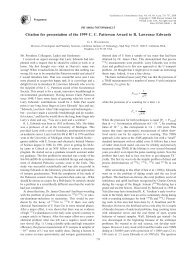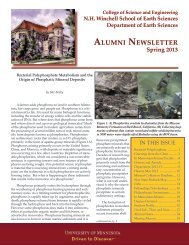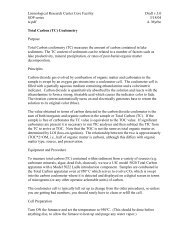ALUMNI NEWSLETTER - Earth Sciences - University of Minnesota
ALUMNI NEWSLETTER - Earth Sciences - University of Minnesota
ALUMNI NEWSLETTER - Earth Sciences - University of Minnesota
Create successful ePaper yourself
Turn your PDF publications into a flip-book with our unique Google optimized e-Paper software.
Bacterial Polyphosphate Metabolism-continued from page 1settings associated with upwelling systems where nutrient-richwaters fuel the blooming <strong>of</strong> photosynthetic algae. The increasedbiologicaloxygen demand that accompanies the decay <strong>of</strong> thisalgal biomass <strong>of</strong>ten results in low-oxygen conditions in shelf sedimentsand bottom waters. One might infer that phosphogenesis ispromoted by the increased export <strong>of</strong> phosphorus from the watercolumn into sediments that accompanies these algal blooms, andthis may in fact be an important aspect <strong>of</strong> phosphogenesis. Butthe concentration <strong>of</strong> phosphate in certain sedimentary pore waterhorizons where apatite is actively precipitating, cannot be easilyexplained by the simple the breakdown <strong>of</strong> organic detritus. Gatheringevidence suggests that microbial processes may be importantfor the concentration <strong>of</strong> phosphate that leads to sedimentaryapatite precipitation.In shelf settings<strong>of</strong>f <strong>of</strong> Namibia, and inother phosphogenicsediments, pore waterphosphate concentrationsand precipitation<strong>of</strong> apatite mineralsis closely associatedwith accumulations <strong>of</strong>bacteria that acquiretheir metabolic energyprimarily through thechemical oxidation <strong>of</strong>hydrogen sulfide, whichthey use to fix CO2 intobiomass in a mannersimilar to plants. Some<strong>of</strong> these bacteria aregiants <strong>of</strong> the microbialworld, with individual cells reaching nearly a millimeter in diameter.These giant cells are adapted to dynamic changes in bottomwater geochemistry that can oscillate between anoxic, sulfidicconditions and oxygenated conditions over periods <strong>of</strong> months.Part <strong>of</strong> that adaptation involves the storage <strong>of</strong> various metabolitesin granules and vacuoles within the cell. One <strong>of</strong> these types <strong>of</strong>inclusions is known to store polyphosphate. Polyphosphates arelinear chains <strong>of</strong> phosphate linked by phosphoanhydride bonds(Figure 2). These polyphosphate molecules have diverse functionsin organisms from all three domains <strong>of</strong> life, including serving asan energy reserve.The role, or roles, <strong>of</strong> polyphosphate in marine microbialecosystems remains poorly understood. However, polyphosphatesappear to play an important role in the precipitation <strong>of</strong>sedimentary apatite. When sulfide-oxidizing bacteria are exposedto sulfidic and/or anoxic conditions, they hydrolyze their polyphosphatestores, likely deriving energy for metabolism under theanoxic or sulfidic conditions. Laboratory experiments show thatthe hydrolysis <strong>of</strong> polyphosphate by these bacteria is sufficient toexplain pore water phosphate enrichments observed in sedimentswhere apatite minerals are precipitating in close proximity to mats<strong>of</strong> sulfide-oxidizing bacteria. Additionally, radioisotope-labelingstudies show a link between the polyphosphate in the cells andapatite precipitation in the surrounding sediments.So, large sulfide-oxidizing bacteria appear to be importantfor the formation <strong>of</strong> apatite in modern sediments. But interestingly,our research group has recently observed a similar release<strong>of</strong> phosphate in response to sulfide exposure from methane seepsediments collected with the remotely-operated vehicle (ROV)Jason from 5000 meter water depths <strong>of</strong>f <strong>of</strong> Barbados (Figure 1B).These sediments were found to contain vacuolate sulfide-oxidizingbacteria, but these sediments are not known to host the precipitation<strong>of</strong> apatite. So perhaps there is more to the story <strong>of</strong> apatiteprecipitation and phosphorite formation than just the concentrationand pulsed release <strong>of</strong> phosphate from polyphosphate-accumulatinggiant microbes? To further complicate the story, we alsoobserved a substantial phosphate release from sulfidic sedimentsin the Santa BarbaraBasin <strong>of</strong>f <strong>of</strong> SouthernCalifornia. Sedimentsfrom the Santa BarbaraBasin <strong>of</strong>ten containlarge sulfide-oxidizingbacteria, but the specificsediments we sampleddid not host thesebacteria. So where didthe observed phosphaterelease come from?Smaller, less obviousbacteria are also knownto store polyphosphate,and perhaps theseorganisms are responsiblefor the observedphosphate release. Ourgroup is investigatingthis hypothesis, in part by looking at the expression <strong>of</strong> genes thatregulate polyphosphate metabolism under various geochemicalconditions via a process known as metatranscriptomics. We hopeto learn more about this process in the near future.Figure 2: Polyphosphates are linear polymers <strong>of</strong> phosphate (A) that can be found ininclusions (bright spots) in diverse eukaryotes such as in this DAPI-stained diatom (B)(nucleus is diffuse blue spot), and bacteria, such as in this culture <strong>of</strong> Halomonas spp. (C)Scale bars = 5 mm. Source: (A) Rao et al., 2009; (B-C) Jones and Bailey unpublished.We are also interested in the formation <strong>of</strong> phosphoritesover geological time scales. We have identified fossilized cells inancient phosphorites that may represent the mineralized remains<strong>of</strong> sulfide-oxidizing bacteria. The taxonomic identification <strong>of</strong> some<strong>of</strong> these structures remains equivocal because reliance on morphologicfeatures can be misleading. However, in other fossilizedbacteria preserved in phosphorites, we have identified geochemicalsignatures that we suggest are diagnostic <strong>of</strong> sulfide-oxidizingbacteria. The oldest <strong>of</strong> these micr<strong>of</strong>ossils occur in 600 million yearold phosphorites. This period <strong>of</strong> geologic time, the Neoproterozoic,is known for an unprecedented explosion in the occurrence <strong>of</strong>mineable phosphorites on nearly every continent. Neoproterozoicrocks also show evidence for the widespread oxygenation <strong>of</strong> theoceans, as opposed to the atmosphere, which is thought to havebecome oxygenated in Paleoproterozoic times. Because sulfideoxidizingbacteria require access to oxygen, or oxygen-dependentchemical species such as nitrate, the correlation between phosphoriteproliferation and the spread <strong>of</strong> oxygen in the Neoproterozoic,may be explained by the expansion <strong>of</strong> conditions that harborpolyphosphate-accumulating bacteria. However, the observationsthat we have recently made in modern sediments suggest that theAlumni NewsletterPage 3
















